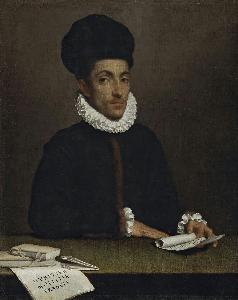Moroni, Giovanni Battista
Giambattista Moroni;Moroni, Giovanni Battista
Place: Albino
Born: 1520
Death: 1578
Biography:
Giovanni Battista Moroni was an Italian painter of the Mannerism movement, born in 1520 and died in 1578. He is also known as Giambattista Moroni and is best known for his elegantly realistic portraits of the local nobility and clergy. Moroni's work is considered some of the greatest portrait paintings of the Cinquecento.
Early Life and Training
Moroni was the son of an architect, Andrea Moroni, and trained under Alessandro Bonvicino in Brescia. He worked in Trento, Bergamo, and his hometown of Albino, where he was born and died. During his stay in Trento, he made contact with Titian and the Count-Bishop, Cristoforo Madruzzo.
Artistic Style and Notable Works
Moroni's portraits are characterized by their sophisticated psychological insight, dignified air, fluent control, and exquisite silvery tonality. His religious canvases, on the other hand, show a more archaic style, recalling the additive compositions of the late Quattrocento. Some of his notable works include The Tailor, which can be found in the National Gallery in London. Key aspects of Moroni's work include:
- His use of naturalism and perspective to create a sense of depth and realism
- His attention to detail, particularly in his portraits, where he captures the subtleties of human emotion
- His ability to balance harmony and balance in his compositions
Influence and Legacy
Moroni's work had a significant influence on the development of portrait painting in Italy. His style, which blended realism with a sense of elegance and refinement, inspired many other artists, including Fra' Galgario and Pietro Longhi. Today, his paintings can be found in museums such as the Uffizi and the National Gallery, where they continue to inspire art lovers and scholars alike. For more information on Moroni's life and work, visit https://Wikioo.org/@/Moroni-Giovanni-Battista or https://en.wikipedia.org/wiki/Giovanni_Battista_Moroni.

